What Is Nowruz? All About the Iranian New Year!
Nowruz, literally translating to "new day" in Persian, signifies the Iranian New Year and the beginning of spring.
Celebrated on the vernal equinox, it usually falls on March 20th or 21st, depending on the astronomical calculations. Nowruz holds deep historical roots, dating back over 3,000 years to the pre-Islamic era of ancient Persia. It marks a time for renewal, new beginnings, and the triumph of light over darkness.
The Story Behind Iranian Nowruz

Nowruz, meaning "new day" in Persian, boasts a history that stretches back over 3,000 years, making it one of the oldest continuously celebrated festivals in the world. Its roots intertwine with the ancient Iranian religion of Zoroastrianism, which emphasized the cyclical nature of life and the battle between good and evil.
Under Zoroastrianism, the spring equinox held immense significance, marking the victory of light and warmth over darkness and cold. This symbolism resonated deeply with the agricultural cycle, where spring represented rebirth and renewed life. The festival likely incorporated elements of earlier traditions, evolving into a celebration of both astronomical and spiritual significance within the Zoroastrian framework.
By the Sasanian Empire (224–651 CE), Nowruz had become a major imperial event. Elaborate rituals were conducted, and the week leading up to the equinox was declared a holiday. The concept of Haft-Seen, the symbolic arrangement of seven items on the Nowruz table, also likely solidified during this period.
Following the Arab conquest of Persia in the 7th century CE, Nowruz continued to be celebrated, albeit with some religious adaptations.
Despite historical changes and religious shifts, Nowruz has remained a cornerstone of Iranian culture and identity. It transcended religious boundaries, becoming a unifying national celebration that cherishes tradition, family, and the beauty of spring.
| Related: Iranian Festivals and Celebrations
How to Prepare for Nowruz
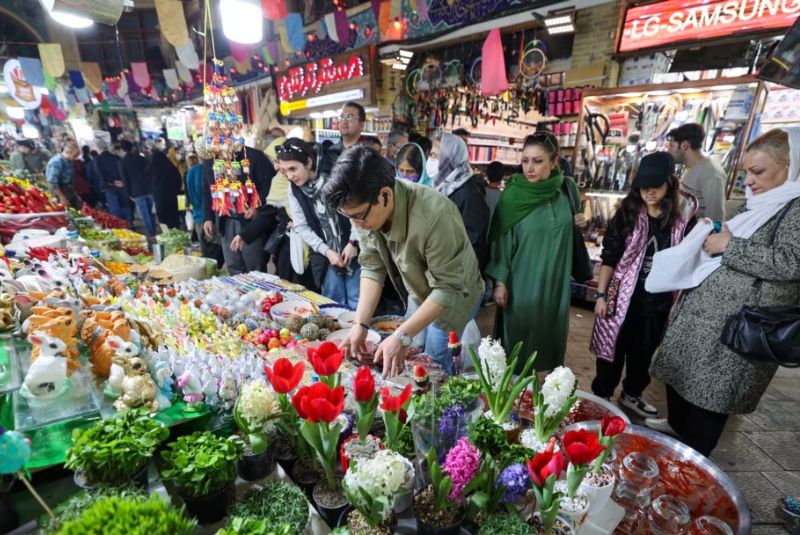
Weeks before the official start of Nowruz, Iranians embark on a series of preparatory activities, transforming the occasion into a much-anticipated event:
- Khöneh takooni (Spring Cleaning): This thorough cleaning ritual signifies the symbolic removal of negativity and inauspiciousness from the past year. Homes are meticulously cleaned, carpets are washed, and decorations are readied, creating a fresh and vibrant atmosphere.
- New Beginnings: Purchasing new clothes is a common tradition, symbolizing a fresh start and embracing the new year with renewed optimism. Families come together to shop for new outfits, adding to the festive spirit.
- Haft-Seen Preparation: The iconic Haft-Seen table, adorned with symbolic items takes center stage. Families gather ingredients, arrange the items, and decorate the table, imbuing the space with meaning and tradition.
- Festive Delights: Special dishes are prepared in anticipation of the celebratory meals enjoyed during Nowruz.
- Gift-giving: Selecting thoughtful gifts for loved ones adds to the joy and excitement of the occasion, strengthening familial bonds and fostering a spirit of generosity.
- Decoration and Embellishment: Homes are adorned with vibrant decorations, often incorporating flowers, hyacinths, and colorful fabrics. This transformation creates a visually appealing and festive environment for gatherings and celebrations.
- Chaharshanbe Suri (Fire Festival): On the Tuesday evening preceding Nowruz, people gather outdoors and jump over bonfires in a ceremony called Chaharshanbe Suri, symbolizing the cleansing of negativity and bad luck from the past year.
These pre-Nowruz rituals not only prepare the physical environment but also create a sense of anticipation and excitement for the joyous festivities to come.
What is 7 Sin?
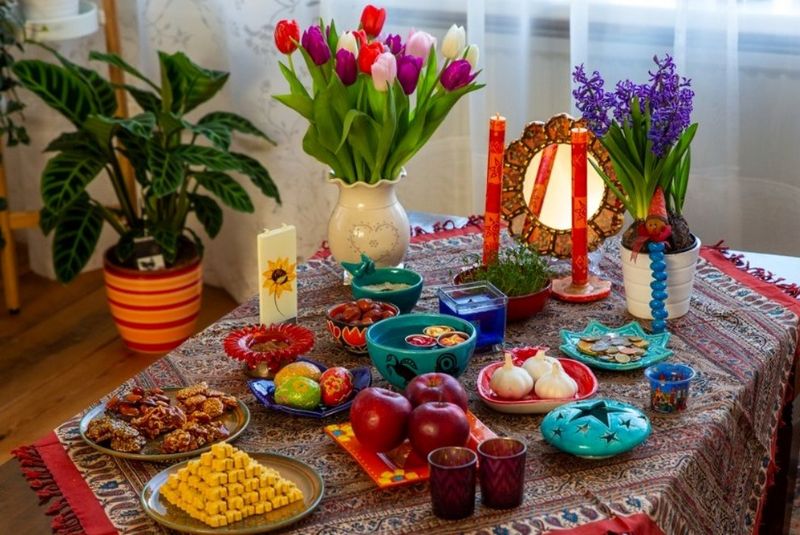
"7 Sin" is a popular term used to refer to Haft-Seen, a central element of the Nowruz celebration. The word "Haft" means "seven" in Persian, and "Seen" represents the letter "S" in the language. Therefore, Haft-Seen literally translates to "seven S's.
Haft-Seen's History
The tradition of Haft-Seen dates back to the Sasanian Empire (224–651 CE). While the specific items might vary regionally, they generally hold symbolic meanings associated with prosperity, health, and renewal. Over time, the tradition has evolved, incorporating additional elements beyond the original seven.
What is the Meaning of Nowruz Table Items (Haft-Seen)?
The seven traditional items found on the Haft-Seen table, each starting with the letter "S" in Persian, are:
- Sabzeh (Sprouts): Symbolizing rebirth and new life, often grown from wheat, lentils, or mung beans.
- Samanu (Wheat pudding): Represents sweetness and prosperity, traditionally made from germinated wheat and cooked for several hours.
- Senjed (Dried lotus berries): Signifies love and patience due to the heart-shaped dried fruit.
- Sir (Garlic): Represents protection against evil and illness, believed to ward off negativity.
- Sumaq (Sumac): Symbolizes the color red, signifying good luck and happiness due to its vibrant color.
- Sib (Apple): Represents health and beauty due to its round shape and association with vitality.
- Serkeh (Vinegar): Symbolizes patience and wisdom, representing the process of transformation and maturity.
The Other Nowruz Table Items Concepts Are:
- A mirror (Ayeneh): Reflecting on the past year and self-reflection, symbolizing introspection and growth.
- Goldfish (Mahi): Symbolizing life, abundance, and transformation, often kept alive throughout the Nowruz festivities.
- Hyacinths and painted eggs: Representing spring and new beginnings, adding vibrant colors and a sense of renewal to the table.
How Iranians Celebrate Nowruz?
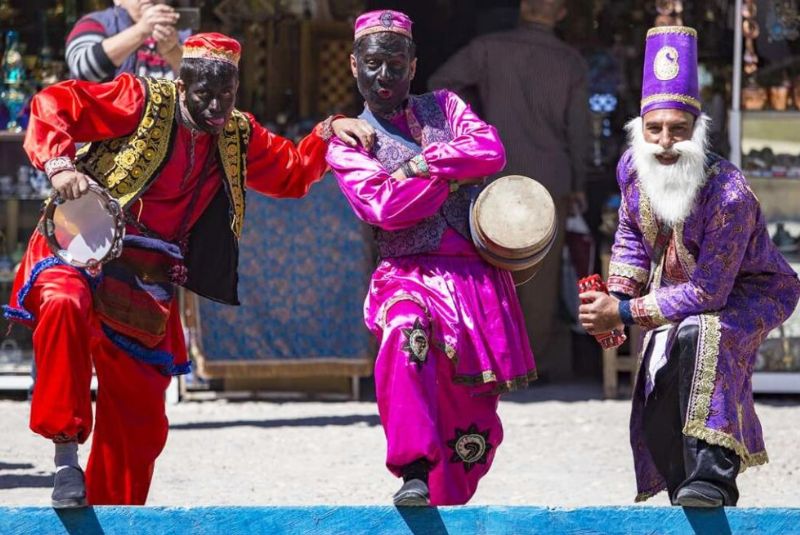
Nowruz, spanning two weeks, is a time for joyous celebrations, vibrant gatherings, and heartfelt connections. As mentioned before, the evening before Nowruz is marked by Chaharshanbe Suri, a fire festival. Families gather outdoors, jumping over bonfires while chanting "Zardiye man az to, sorkhiye to az man" ("My yellowness to you, your redness to me"), symbolizing the exchange of negativity for good fortune.
On the first day of Nowruz, families gather for a special feast featuring traditional dishes. They exchange gifts, especially elders offering money and presents to children in a tradition called “Eidi.” Visits to relatives and friends become a central part of the celebration, fostering social bonds and strengthening community spirit.
Throughout the two weeks, families and friends visit each other, exchanging well wishes, strengthening bonds, and sharing stories. Younger generations often visit and pay respects to elders.
The thirteenth day of Nowruz, Sizdah Bedar or "getting rid of the thirteenth", marks the official end of the festivities. Families and friends head outdoors for picnics, enjoying nature and casting away the sprouted greens from their Haft-Seen tables into flowing water, symbolizing letting go of the old and welcoming the new.
Traditional music, dance performances, and poetry readings often accompany the festivities, adding to the vibrant atmosphere and cultural immersion.
| Read more: The Greatest Persian Poets throughout the History
What Foods are Served During Nowruz?
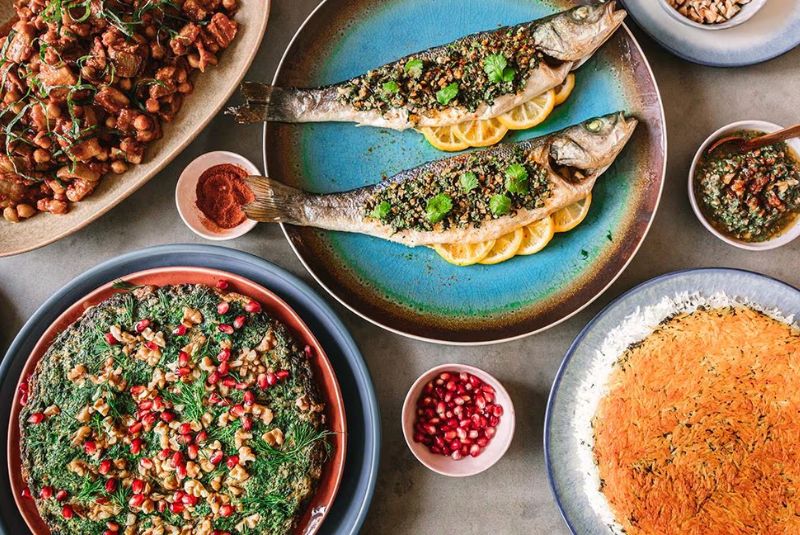
Nowruz celebrations are not complete without a delectable array of traditional dishes. These culinary delights hold special significance and add to the festive spirit:
- Sabzi Polo (Herbed Rice): This fragrant rice dish, featuring fresh herbs like dill, parsley, and chives, is a staple on the Nowruz table.
- Mahi (Fish): Typically fried or baked, fish represents life and fertility, reminding celebrants of renewal and new beginnings.
- Ash-e Reshteh (Noodle Soup): This Persian soup, featuring noodles, lentils, and vegetables, is often enjoyed as a starter or light meal.
- Kuku Sabzi (Herb Frittata): A savory and flavorful dish made with eggs, fresh herbs, and spices, Kuku Sabzi is a popular choice for breakfast or snacks.
- Dolmeh (Stuffed Grape Leaves): These small, filled parcels, traditionally containing rice, herbs, and meat, offer a burst of flavor and symbolize creativity and craftsmanship.
- Shirini (Pastries): Various types of Persian pastries, such as Nan-e Nokhodchi (chickpea cookies) and Baqlava, are enjoyed throughout the festivities, adding a touch of sweetness to the celebration.
- Chai (Tea): A staple in Iranian culture, tea is typically offered to guests throughout the day, fostering conversation and social interaction.
- Sharbat (Fruit Drinks): Refreshing and flavorful drinks made with fruits like rosewater, saffron, and berries are popular choices during Nowruz celebrations.
- Ajil (Trail Mix): This delightful combination of nuts, dried fruits, and seeds, often served alongside tea, is a popular Nowruz snack. It symbolizes abundance, variety, and good health.
| Related: Persian Food
Beyond Iranian Borders: Where is Nowruz Celebrated?
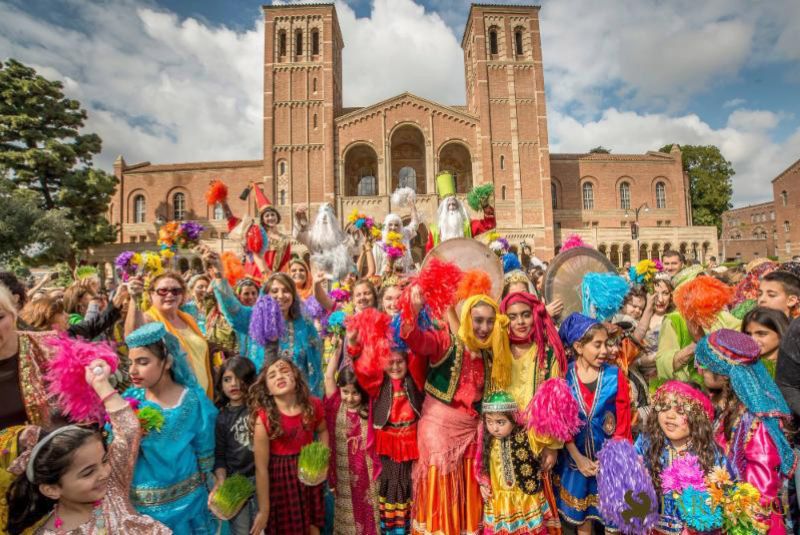
In 2009, Nowruz was inscribed on the UNESCO Representative List of the Intangible Cultural Heritage of Humanity, further solidifying its global significance. While Nowruz finds its roots in Iran, its significance extends far beyond its national borders. Here's the global reach of this vibrant tradition:
- Afghanistan: Celebrated as Nauroz, it marks the official start of the new year with traditional food, family gatherings, and public festivities.
- Azerbaijan: Noted for its elaborate celebrations, including official parades, cultural events, and visits to historical sites.
- Central Asian nations: Countries like Kazakhstan, Tajikistan, and Kyrgyzstan observe Nowruz with traditional customs, often incorporating unique regional elements.
Nowruz is also celebrated by Iranian communities around the world, with major celebrations happening in the United States and Europe. Cities like Los Angeles, which boasts a large Persian community, and Phoenix, Arizona, hold significant Nowruz festivities. In fact, nearly every state in the US hosts its own Nowruz celebration, highlighting the widespread observance of this cultural tradition.
How to Say Happy New Year in Persian?
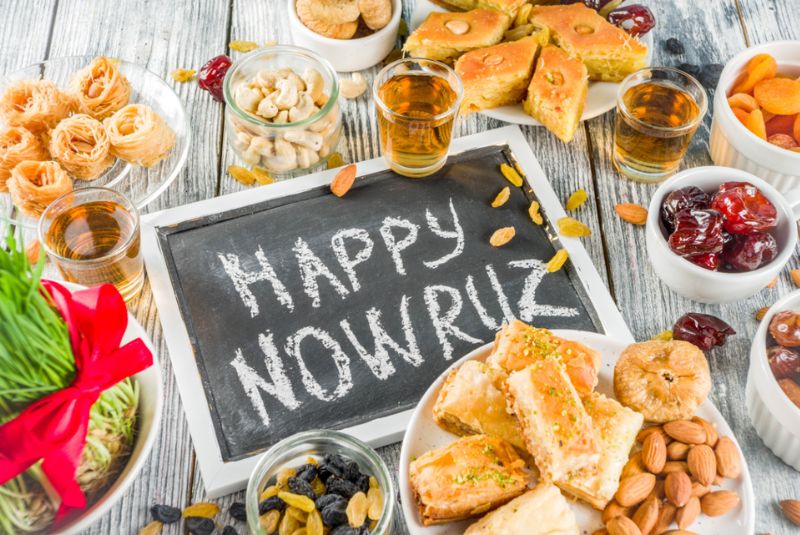
There are several ways to say "Happy New Year" in Persian, depending on the context and your level of formality:
- Nowruz Mobarak! (نوروز مبارک): This is the most common and formal way to say "Happy Nowruz." It literally translates to "Happy New Day." This is perfect for greeting anyone, including elders, colleagues, or people you don't know well.
- Eyd e Shoma Mobarak! (عید شما مبارک): This option translates to "Happy Holiday to you!" and is slightly more formal than "Nowruz Mobarak." It's suitable for formal situations or when addressing someone with respect.
- Sal-e No Mobarak! (سال نو مبارک): This translates to "Happy New Year!" and is a more general way to say it, similar to English. It can be used in informal settings or with friends and family.
- Nowruz Pirouz! (نوروز پیروز): This literally translates to "Victorious Nowruz!" and is a more festive and informal way to say Happy Nowruz. It's suitable for celebrations and expressing joy for the occasion.
| Discover: Most Common Farsi Phrases for Tourists in Iran
Nowruz 2024 Date and Time
Nowruz in 2024 falls on Wednesday, March 20th. Here's the specific time in the United Kingdom:
- March 20, 2024, at 3:06 AM (United Kingdom Time)
This is because the United Kingdom observes Greenwich Mean Time (GMT) which is 5 hours behind Iran Standard Time (IRST). Therefore, when Nowruz begins in Iran at 6:36 AM IRST, it's still early morning in the UK at 3:06 AM GMT.
Final Takeaway
Whether you're planning a trip to Iran or simply seeking to broaden your cultural understanding, learning about Nowruz ( Iranian New Year) fosters appreciation for the diverse ways people around the world celebrate and connect with their heritage. So, the next time you encounter someone celebrating Nowruz, don't hesitate to offer a warm "Nowruz Mobarak!" and share in the spirit of this special occasion.
Share your story!
Comment below and let us know about your Experience.
Your story inspires others!


Comment
Leave a Comment